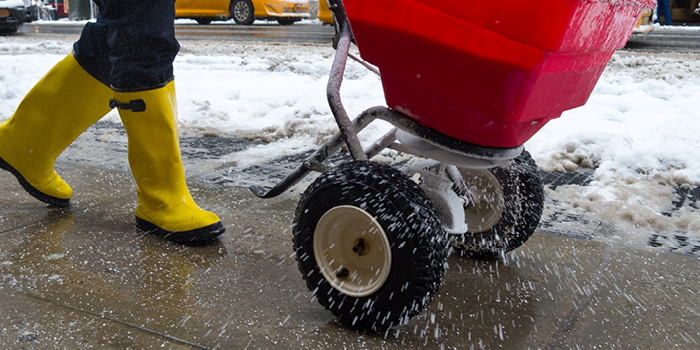- Home
- Loss Control
- Loss Control Insights
- Winter slip, trip, and fall prevention guide
Winter brings specific hazards, and preventing slip, trip, and fall accidents becomes critical for maintaining safety. Here are essential tips to minimize these risks during colder months.
1. Prepare outdoor areas for icy conditions
Clearing outdoor areas, like sidewalks, parking lots, and entryways, can significantly reduce slip and fall hazards. Salt, sand, and other de-icing agents should be readily available and applied as needed.
2. Use non-slip footwear
One effective slip, trip, and fall prevention measure is promoting proper footwear. Encourage employees and visitors to wear shoes with good traction and insulation, reducing the chances of slips on icy or wet surfaces.
3. Proper use of equipment
Using snow shovels and ice scrapers effectively can help maintain walkways. Train staff on the best practices for these tools to ensure they’re used safetly.
4. Regularly monitor and remove snow accumulation
Quickly clear snow accumulation from walkways and frequently used paths. Removing snow promptly and reapplying de-icer after each clearing helps maintain a safer environment.
5. Conduct safety audits
Regular safety audits can help identify and address potential hazards, ensuring that preventive measures are in place before winter weather arrives.
6. Encourage personal awareness
Remind everyone to be mindful of their surroundings and assess conditions before moving, as awareness can prevent slip and fall accidents.
7. Install slip-resistant mats
Place slip-resistant mats in entryways and high-traffic areas where snow and water can create slip hazards. This simple addition can prevent many slip and fall accidents by keeping floors dry and stable.
8. Promptly address indoor wet spots
Snow and ice tracked indoors can lead to wet spots, increasing the risk of falls. Implement a regular cleaning schedule for wet floors and ensure visible signs are in place to warn of slip hazards.
9. Provide employee training on winter safety
Employee awareness is essential for winter slip, trip, and fall prevention. Training employees on how to walk on slippery surfaces and how to recognize hazards fosters a safer environment.
10. Enhance lighting in key areas
Proper lighting ensures potential hazards, like ice patches, are visible. Install or improve lighting around walkways, entryways, and parking lots to support slip and fall accident prevention efforts.
11. Encourage slow and deliberate movements
Advise employees and visitors to walk slowly and take shorter steps on potentially slick surfaces. This tip helps reduce the chances of losing balance on ice.
12. Ensure proper drainage and water control
Melting snow and ice can create slippery areas indoors and out. Make sure all drainage systems are clear and direct water away from high-traffic zones to prevent icy build-up.
13. Install handrails for support
Adding handrails in entryways, ramps, and stairs provides essential support for individuals navigating icy or uneven surfaces, decreasing slip and fall risks.
14. Have an emergency response plan
Ensure there’s a clear emergency response plan in place for slip and fall accidents, so everyone knows how to react quickly and efficiently if an incident occurs.
Give yourself peace of mind
Keeping everyone safe during winter is a shared responsibility, and it pays off in more ways than one. Not only does it protect your team and customers, but it also helps your business avoid costly slip, trip, and fall accidents. That’s where the right insurance comes in. Workers' compensation has your employees' backs if they get hurt, while general liability covers you if someone gets injured on your property. For contractors and manufacturers, specialized policies can help manage the unique risks of your trade. Investing in comprehensive coverage not only fosters a safer environment but also gives you peace of mind.
Get in touch
Need help? We’re here for you! Whether you have questions or need personalized assistance, your local office is ready to support you.
Loss Control Insights
Stay informed with the latest news and receive actionable safety tips, all carefully curated by our team of experts.
